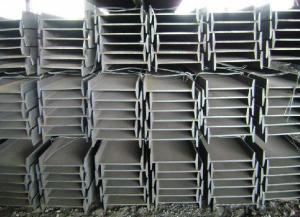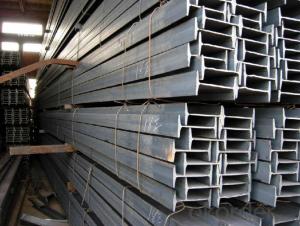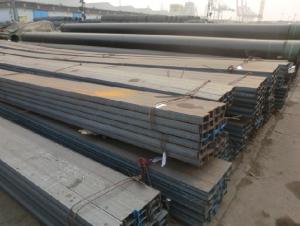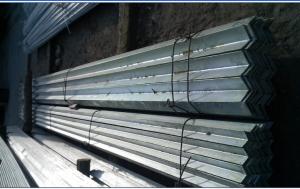hot rolled high quality IPE IPEAA GB Q235 S235JR
- Loading Port:
- Shanghai
- Payment Terms:
- TT OR LC
- Min Order Qty:
- 25 m.t.
- Supply Capability:
- 60000 m.t./month
OKorder Service Pledge
OKorder Financial Service
You Might Also Like
IPE Details:
| Minimum Order Quantity: | Unit: | m.t. | Loading Port: | ||
| Supply Ability: | Payment Terms: | Package: | wire rod bundle |
Product Description:
Product Description:
Specifications of IPE Beam
1. Invoicing on theoretical weight or actual weight as customer request
2. Standard: EN10025, GB Standard, ASTM
3. Grade: Q235B, Q345B, SS400, ASTM A36, S235JR, S275JR
4. Length: 5.8M, 6M, 9M, 12M as following table
5. Sizes: 80mm-270mm
Dimensions(mm) | |||||
h | b | s | t | Mass Kg/m | |
IPE80 | 80 | 46 | 3.80 | 5.20 | 6.00 |
IPE100 | 100 | 55 | 4.10 | 5.70 | 8.10 |
IPE120 | 120 | 64 | 4.80 | 6.30 | 10.40 |
IPE140 | 140 | 73 | 4.70 | 6.90 | 12.90 |
IPE160 | 160 | 82 | 5.00 | 7.40 | 15.80 |
IPE180 | 180 | 91 | 5.30 | 8.00 | 18.80 |
IPE200 | 200 | 100 | 5.60 | 8.50 | 22.40 |
IPE220 | 220 | 110 | 5.90 | 9.20 | 26.20 |
IPE240 | 240 | 120 | 6.20 | 9.80 | 30.70 |
IPE270 | 270 | 135 | 6.60 | 10.20 | 36.10 |
Appications of IPE Beam
1. Supporting members, most commonly in the house raising industry to strengthen timber bears under houses. Transmission line towers, etc
2. Prefabricated structure
3. Medium scale bridges
4. It is widely used in various building structures and engineering structures such as roof beams, bridges, transmission towers, hoisting machinery and transport machinery, ships, industrial furnaces, reaction tower, container frame and warehouse etc.
Package & Delivery of IPE Beam
1. Packing: it is nude packed in bundles by steel wire rod
2. Bundle weight: not more than 3.5MT for bulk vessel; less than 3 MT for container load
3. Marks: Color marking: There will be color marking on both end of the bundle for the cargo delivered by bulk vessel. That makes it easily to distinguish at the destination port.
4. Tag mark: there will be tag mark tied up on the bundles. The information usually including supplier logo and name, product name, made in China, shipping marks and other information request by the customer.
If loading by container the marking is not needed, but we will prepare it as customer request.
5. Transportation: the goods are delivered by truck from mill to loading port, the maximum quantity can be loaded is around 40MTs by each truck. If the order quantity cannot reach the full truck loaded, the transportation cost per ton will be little higher than full load.
6. Delivery of IPE Beam: 30 days after getting L/C Original at sight or T/T in advance
Production flow of IPE Beam
Material prepare (billet) —heat up—rough rolling—precision rolling—cooling—packing—storage and transportation
- Q:What are the environmental impacts of steel I-beam production?
- The production of steel I-beams has a variety of environmental consequences. To begin with, the extraction of iron ore, which serves as the primary raw material for steel production, results in substantial deforestation and the destruction of habitats. Mining operations can disrupt ecosystems and cause wildlife to be displaced. The process of converting iron ore into steel also leads to the emission of greenhouse gases, notably carbon dioxide (CO2). The high temperatures necessary to extract iron from ore and transform it into steel contribute to the release of CO2, a major contributor to climate change. Moreover, steel production consumes a lot of energy, requiring significant amounts of electricity and fossil fuels, thereby exacerbating greenhouse gas emissions. Water pollution is another significant environmental consequence of steel production. The manufacturing process involves the use of various chemicals, including solvents and acids, which, if not managed properly, can contaminate water sources. Wastewater from steel mills often contains heavy metals and other pollutants, which can have detrimental effects on aquatic ecosystems and human health if not adequately treated. Additionally, the production of steel I-beams generates waste in the form of slag and other by-products. These waste materials can contain harmful substances and must be appropriately disposed of to prevent contamination of soil and water. Transportation also contributes to the environmental impacts of steel I-beam production. The transportation of raw materials, such as iron ore and coal, as well as the shipment of finished steel products, results in air pollution and carbon emissions. Efforts have been made in recent years to mitigate the environmental impacts of steel production. Steel manufacturers have implemented technologies to enhance energy efficiency and reduce emissions. Furthermore, recycling steel is an effective means of minimizing the environmental footprint of steel production, as it reduces the need for extracting raw materials and energy-intensive processes. Overall, while steel I-beams are crucial for construction and infrastructure projects, their production has significant environmental implications. It is essential for the industry to continue implementing sustainable practices and exploring alternative materials and manufacturing processes to minimize these impacts.
- Q:What does "No. ten I-beam" mean? How is the number of I-beam divided?
- No. ten I-beam refers to the cross section height of 100 mm. That is 10 centimeters.
- Q:I-beam shelf - shelf materials from what can be roughly divided into?
- Alloy shelves: it is an improved version of the aluminum shelf, improved its carrying capacity;
- Q:Can Steel I-Beams be used for basement construction?
- Yes, steel I-beams can be used for basement construction. Steel I-beams are commonly used in construction due to their strength and durability. When it comes to basement construction, steel I-beams are often used as part of the foundation system to support the weight of the structure above. They are particularly useful in basements as they can span long distances without the need for additional support columns, allowing for more open and flexible floor plans. Additionally, steel I-beams are resistant to moisture and pests, making them a suitable choice for basement construction where these factors may be a concern. Overall, steel I-beams are a reliable and popular choice for basement construction due to their structural integrity and ability to provide the necessary support for the building.
- Q:What are the different connection methods for Steel I-Beams?
- There are several different connection methods for Steel I-Beams, depending on the specific application and structural requirements. Some of the common connection methods include: 1. Welding: This is the most common method used to connect steel I-beams. It involves melting the base metal and applying a filler material to create a strong joint. Welding provides excellent strength and rigidity, making it suitable for heavy-duty applications. 2. Bolting: Bolts can be used to connect steel I-beams together. This method involves drilling holes in the flanges or web of the I-beams and inserting bolts through these holes, along with washers and nuts, to tighten and secure the connection. Bolting provides ease of installation and disassembly, making it suitable for temporary or adjustable structures. 3. Riveting: Rivets are another traditional method of connecting steel I-beams. This process involves inserting a rivet through pre-drilled holes in the flanges or web of the I-beams and then deforming the rivet to create a permanent connection. Riveting provides high strength and reliability but requires specialized tools and expertise. 4. Adhesive bonding: In some cases, adhesive bonding can be used to connect steel I-beams. This method involves applying a high-strength adhesive to the surfaces of the I-beams and then pressing them together to create a bond. Adhesive bonding can provide a clean and aesthetically pleasing connection, but it may not be suitable for heavy loads or dynamic loads. 5. Mechanical connectors: There are various mechanical connectors available in the market specifically designed for connecting steel I-beams. These connectors are often prefabricated and can be easily installed by bolting or welding. They provide a quick and efficient method of connecting I-beams while maintaining high strength and load-bearing capacity. It is important to consider the specific structural requirements, load conditions, and design constraints when selecting the appropriate connection method for steel I-beams. Consulting with a structural engineer or a qualified professional is recommended to ensure the chosen connection method meets the necessary standards and specifications.
- Q:What are the factors to consider when selecting the right steel I-beam size?
- When it comes to choosing the correct size for a steel I-beam, there are several factors that need to be taken into account. These factors include the load requirements, the length of the span, the limits of deflection, and the cost. To begin with, the load requirements refer to the weight or load that the steel I-beam will need to support. This includes both the static load, which is the weight of the structure itself, and the dynamic load, which comes from occupancy, furniture, or other equipment. It is crucial to accurately determine the load requirements in order to ensure that the chosen steel I-beam is strong enough to support the intended load without any deformation or failure. Next, the span length is another important factor to consider. This refers to the distance between the supports or columns where the steel I-beam will be placed. The longer the span length, the greater the potential for deflection or bending of the beam. Therefore, it is essential to select a steel I-beam size that can adequately handle the span length and minimize any deflection within acceptable limits. Deflection limits are also crucial to take into consideration. Deflection refers to the bending or flexing of the steel I-beam under load. Different applications and building codes have specific deflection limits that must be followed. These limits ensure that the structure remains safe and stable. Therefore, the chosen steel I-beam size should be able to meet the required deflection limits for the specific application. Lastly, cost is a factor that should not be overlooked. Different sizes and types of steel I-beams come at different costs. It is important to consider budget constraints and strike a balance between cost and performance. While it may be tempting to choose a smaller beam size to save money, it is crucial to ensure that the chosen size can adequately meet the load requirements and span length without compromising safety or structural integrity. In conclusion, selecting the appropriate size for a steel I-beam involves taking into account factors such as load requirements, span length, deflection limits, and cost. By carefully evaluating these factors, one can choose the most suitable steel I-beam size that meets the structural needs while staying within the budget.
- Q:Can Steel I-Beams be painted or coated for corrosion protection?
- Yes, steel I-beams can be painted or coated for corrosion protection.
- Q:What are the different types of steel I-beam connections?
- There are several different types of steel I-beam connections, including bolted connections, welded connections, and moment connections.
- Q:Can steel I-beams be used in agricultural or rural construction projects?
- Yes, steel I-beams can be used in agricultural or rural construction projects. Steel I-beams are commonly used in construction due to their strength and durability. They provide structural support and can be used for various purposes, including creating the frames for barns, sheds, or other agricultural structures. Steel I-beams are resistant to pests, rot, and fire, making them a suitable choice for rural construction projects where durability and longevity are important factors.
- Q:How do steel I-beams perform in terms of vibration resistance?
- Steel I-beams are known for their excellent vibration resistance, making them a preferred choice in structural applications where minimizing vibrations is crucial. The inherent stiffness and rigidity of steel I-beams help to dampen and dissipate vibrations, ensuring stability and preventing excessive movement. Additionally, their high strength-to-weight ratio further enhances their ability to withstand dynamic loads and reduces the risk of resonance or vibration amplification. Thus, steel I-beams exhibit exceptional performance in terms of vibration resistance, making them reliable and dependable structural components.
1. Manufacturer Overview |
|
|---|---|
| Location | |
| Year Established | |
| Annual Output Value | |
| Main Markets | |
| Company Certifications | |
2. Manufacturer Certificates |
|
|---|---|
| a) Certification Name | |
| Range | |
| Reference | |
| Validity Period | |
3. Manufacturer Capability |
|
|---|---|
| a)Trade Capacity | |
| Nearest Port | |
| Export Percentage | |
| No.of Employees in Trade Department | |
| Language Spoken: | |
| b)Factory Information | |
| Factory Size: | |
| No. of Production Lines | |
| Contract Manufacturing | |
| Product Price Range | |
Send your message to us
hot rolled high quality IPE IPEAA GB Q235 S235JR
- Loading Port:
- Shanghai
- Payment Terms:
- TT OR LC
- Min Order Qty:
- 25 m.t.
- Supply Capability:
- 60000 m.t./month
OKorder Service Pledge
OKorder Financial Service
Similar products
New products
Hot products
Hot Searches
Related keywords































